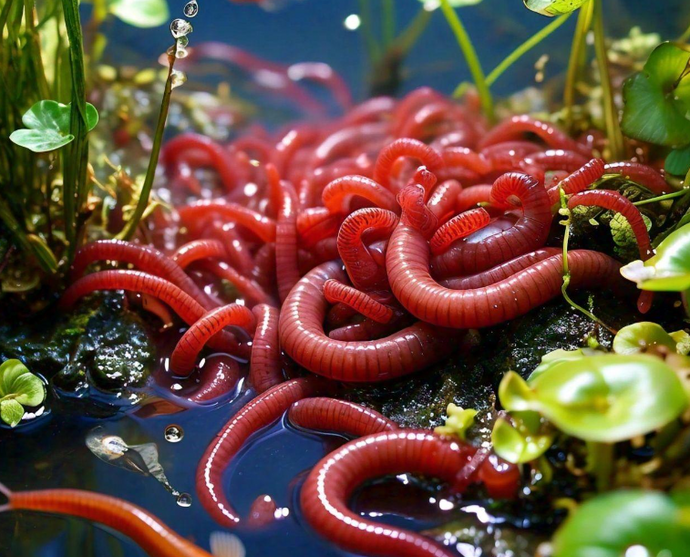Red worms: Improve your garden naturally
Red worms: Improve your garden naturally
Blog Article
Utilizing Red Wigglers for Reliable Organic Garbage Disposal
The usage of red wigglers for natural waste disposal offers an engaging technique to taking care of food scraps while advertising environmental sustainability. These worms not just boost waste decomposition however likewise generate valuable worm spreadings, which can significantly improve dirt health. Their capacity to refine big quantities of organic material with minimal effort positions them as an accessible service for homes and areas alike. However, recognizing the nuances of establishing an effective worm container and maintaining an optimal habitat is crucial for maximizing their advantages. The next steps in this procedure may stun you.
Benefits of Making Use Of Red Wigglers
Among one of the most compelling advantages of using red wigglers for natural waste disposal is their exceptional effectiveness in composting. These worms, clinically called Eisenia fetida, are especially adapted for damaging down natural products, enabling them to process waste as much as two times their body weight daily. This quick disintegration not just increases the composting process yet also creates nutrient-rich worm castings that significantly improve dirt high quality.
Furthermore, red wigglers add to a reduction in land fill waste. By drawing away natural products from garbage dumps, they help minimize methane discharges-- a potent greenhouse gas. This environmental benefit is important in the battle versus climate adjustment.
Moreover, red wigglers are low-maintenance and can prosper in numerous settings, making them accessible for both newbie and experienced composters. Their ability to reproduce swiftly guarantees a consistent population, assisting in continuous waste processing.
Establishing Your Worm Bin
Developing an efficient worm bin is vital for making best use of the advantages of composting with red wigglers. The very first step is picking a suitable container. A container constructed from plastic or wood, with a capacity of 10 to 20 gallons, is ideal. Guarantee the container has sufficient drain openings to avoid excess moisture, as red wigglers flourish in a damp however not soggy environment.
(Lake Rhodhiss Worms)Following, prepare the bed linens product, which functions as the worms' habitat and food resource. Shredded newspaper, cardboard, and coconut coir are excellent alternatives. Go for a bed linen depth of around 4 to 6 inches. The bin must be placed in a dark, temperature-controlled area, ideally in between 55 ° F and 77 ° F, to keep worm activity.
When the container is set up, present the red wigglers, enabling them to adjust to their new environment. A properly maintained bin will certainly not only sustain the wellness of the worms however also assist in reliable disintegration of natural waste.
(Lake Hickory Bait)
What to Feed Red Wigglers
An understanding of the ideal diet for red wigglers is essential for keeping a healthy worm population and enhancing composting effectiveness. Red wigglers thrive on a diverse diet plan that mainly is composed of natural products. Suitable food resources include vegetable scraps, fruit peels, coffee grounds, eggshells, and shredded paper. These things not just provide essential nutrients but likewise add to the wetness equilibrium within the worm bin.
It is critical to prevent certain foods that can harm the worm populace. Red wigglers ought to not be fed meat, dairy items, oily foods, or refined things, as these can bring in parasites and produce unpleasant smells. red wigglers. Furthermore, citrus fruits and zesty foods need to be reduced, as their acidity can be harmful to worms
To promote optimal food digestion, food should be sliced right into smaller pieces, promoting quicker break down and intake. Presenting food in moderation is likewise crucial; overfeeding can result in anaerobic conditions and attract undesirable bugs. Monitoring the worm bin for food usage rates will certainly aid ensure that red wigglers are receiving an adequate diet while preserving an efficient composting setting. Appropriate feeding practices are important for cultivating a prospering community within the worm bin.
Preserving Your Worm Habitat
A properly maintained worm habitat is vital for the health and efficiency of red wigglers. To ensure optimal conditions, it is essential to keep track of temperature, moisture, and aeration within the worm bin (red wigglers).
Dampness degrees should be kept constant; the bed linen needs to perspire but not soggy. A good guideline is to preserve wetness at roughly 70% to 80%. If the bed linens becomes too damp, it can bring about anaerobic problems that are unsafe to the worms. Including dry carbon-rich materials, such as shredded paper or cardboard, can aid soak up excess moisture.

Utilizing Worm Castings in Horticulture
Rich in nutrients and helpful microorganisms, worm castings work as a remarkable organic fertilizer for gardening. Generated through the gastrointestinal processes of red wigglers, these spreadings include a variety of necessary nutrients, consisting of nitrogen, phosphorus, and potassium, which promote robust plant growth. Unlike artificial fertilizers, worm spreadings supply a slow-release mechanism, guaranteeing that nutrients are readily available to plants over a prolonged period, consequently reducing the risk of nutrient leaching and dirt deficiency.
In enhancement to nutrient material, worm spreadings boost dirt structure and aeration, enhancing wetness retention and drainage. The microbial life existing in worm castings assists to subdue virus and advertises a healthy and balanced soil ecological community, further profiting plant health and useful link wellness. When included into the soil or utilized as a leading clothing, worm castings can dramatically increase seed germination prices, origin development, and total plant vitality.
For optimal outcomes, gardeners should use worm spreadings at a rate of 1-2 inches per square foot, blending them into the dirt or including them into potting mixes. Overall, making use of worm castings is an environmentally friendly technique to improving dirt fertility and making certain flourishing garden environments.
Conclusion

Report this page